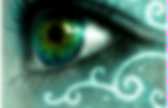

WHAT: is visual literacy? What is Visual Literacy?
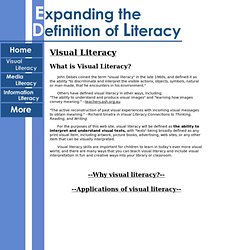
John Debes coined the term "visual literacy" in the late 1960s, and defined it as the ability "to discriminate and interpret the visible actions, objects, symbols, natural or man-made, that he encounters in his environment. " Others have defined visual literacy in other ways, including: "The ability to understand and produce visual images" and "learning how images convey meaning. " Visual Literacy. Visual Literacy | Advantages | Art | Charts | Definition | Graphic Organizers | Illustrated Books | Maps | References | Visual Texts | updated September 17, 2005 What is Visual Literacy ?

The International Visual Literacy Association defines visual literacy as the ability to discriminate and interpret visual actions, objects, and other images, while gaining meaning from them. Picturing visual literacy in the classroom. Research shows that Visual Literacy, “a person’s ability to interpret and create visual information—to understand images of all kinds and use them to communicate more effectively,” is a successful strategy for all learners (Burmark, 2002, p. v).
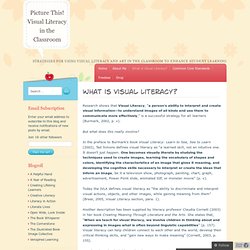
But what does this really involve? In the preface to Burmark’s book Visual Literacy: Learn to See, See to Learn (2002), Tad Simons defines visual literacy as “a learned skill, not an intuitive one. It doesn’t just happen. One becomes visually literate by studying the techniques used to create images, learning the vocabulary of shapes and colors, identifying the characteristics of an image that gives it meaning, and developing the cognitive skills necessary to interpret or create the ideas that inform an image, be it a television show, photograph, painting, chart, graph, advertisement, Power Point slide, animated GIF, or monster movie” (p. v). So what does this look like in the classroom? An emerging concept. ETEC540: Text, Technologies – Community Weblog. The Importance of Teaching Visual Literacy Skills Visual content is on the rise in print and in digital media (Bolter, 2001).
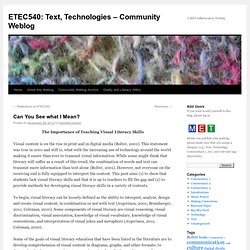
This statement was true in 2001 and still is, what with the increasing use of technology around the world making it easier than ever to transmit visual information. WHO: Visual Literacy for Young Children. Lesson plans for visual literacy. I was thinking about a catchy title for this article and the saying ‘A picture paints a thousand words’ popped into my head.

Ever keen to prevaricate, I typed the phrase into a search engine and came up with over 83000 results. Turning to the Oxford Dictionary of Quotations, I discovered that I had the wording wrong. The expression is actually ‘One picture is worth ten thousand words’ - it was used in the 1920s as an advertising slogan for baking powder and, rightly or wrongly, cited as an ancient Chinese proverb. I was now at risk of getting carried away in my research and I thought, 1000 or 10000 words - does it really matter?
The fact remains: pictures can, in a single glimpse, tell us an awful lot more than words convey in that same space or time. Using paintings Paintings and other artwork are a readily accessibly resource that can be used as a visual stimulus for writing. Using photographs Using picture books Finally, let’s move onto picture books. Moving images. Visual Literacy Instruction in K-12 Education: What is Visual Literacy and Why Should we Teach It? Rationale for Visual Literacy in School Instruction In the 1920s, Thomas Edison had a belief that motion pictures would make the school textbook obsolete within ten years.
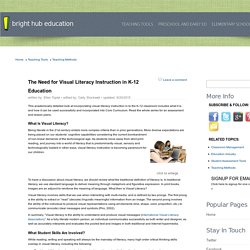
That did not happen, but technology and media have taken a primary place in the communication of ideas and information. “Educators implementing new English language arts curricula know that today’s youth have to handle a world that contains multiple forms of literacy” (Begoray, 2001, p. 1). Young children already are pre-destined to venture into a dual mode of communicating and understanding information through different modalities. Several researchers have explored the concept of how children comprehend text, which relates to the validity behind visual literacy strategies. Understanding text cognitively involves multiple sensory processes, and interpreting visual imagery does too.
Are you visually literate? Are your kids? What's going on in this image from the U.S.
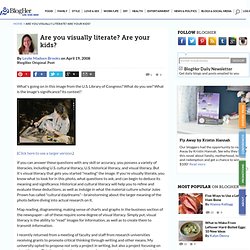
Library of Congress? What do you see? What is the image's significance? Its context? (Click here to see a larger version.) If you can answer these questions with any skill or accuracy, you possess a variety of literacies, including U.S. cultural literacy, U.S. historical literacy, and visual literacy. Map reading, diagramming, making sense of charts and graphs in the business section of the newspaper--all of these require some degree of visual literacy. I recently returned from a meeting of faculty and staff from research universities receiving grants to promote critical thinking through writing and other means. Early Literacy For Children With Additional Needs. Hello and welcome to Planning With Kids!
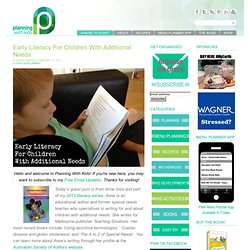
If you're new here, you may want to subscribe to my Free Email Updates. Thanks for visiting! Today’s guest post is from Anne Vize and part of my 2013 literacy series. Art classes for children. Reading Young Children's Visual Texts. Share Mirar esta página en españolHomeJournal ContentsIssue ContentsVolume 7 Number 1©The Author(s) 2005 "Reading" Young Children's Visual Texts Sylvia Pantaleo University of Victoria This article discusses a study that explored first-grade students' responses to and interpretations of eight picture books with metafictive devices.
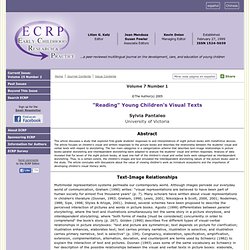
The article focuses on children's visual and written responses to the picture books and describes the relationship between the students' visual and verbal texts with respect to storytelling. The two main categories in a categorization scheme that describes text-image relationships in picture books-parallel storytelling and interdependent storytelling-were adapted to analyze the students' visual and written responses. WHEN: to use Visual Literacy. Now not when. The role of picture books. Maria Nikolajeva Verbal and visual literacy: The role of picturebooks in the reading experience of young children There seems to be a common understanding among scholars and educators that referring to the reading experience of young children we often speak about texts in which words and pictures are equally represented.

Although young children are naturally exposed to other types of texts, narrative as well as non-narrative – for instance, fairytales and stories, nursery rhymes, and songs – these will most likely be presented in oral form. By contrast, the child's first encounter with written texts probably includes images as well as words. Adapting Literacy Activities for Young Children. By Linda Robinson Young children learn literacy skills in a variety of ways as they play, handle books, observe adults using print materials, and interact with others during storybook reading.
One of the keys to successful acquisition of literacy is children's active participation in literacy activities. Children need to be actively involved in handling books and interacting with family members and teachers during reading time. Visual Literacy in Teaching & Learning. WHY: Visual Literacy? How is visual literacy beneficial to children? According to development theory and research, children must master visual skills before they can even begin to develop verbal skills--some theorists even argue that visual skills are a necessary foundation for later speech and reading skills.
A child looks at the world and is forced to identify objects and make sense of what he or she sees. Values of visual literacy strategies. Engaging the Eye Generation. Product Details Author: Johanna RiddleISBN: 978-157110-749-7Year:2009Media: 168 pp/paperGrade Range: K-5Item No: WEB-0749 Literacy in the twenty-first century means more than just reading and writing. Today's students must learn how to interpret and communicate information through a variety of digital and print-based media formats, using imagery, online applications, audio, video, and traditional texts.
In Engaging the Eye Generation, library media specialist and National Board Certified Teacher Johanna Riddle draws on twenty-five years of education experience to show teachers how to update the curriculum for twenty-first century learners. Technology neophytes need not despair. What We See and Why It Matters... The Critical Eye: Visual Literacy as a Tool. Why might visual literacy be discouraged?
I See What You Mean: chapter 1 (Steve Moline) I See What You Mean Visual Literacy K-8 by Steve Moline Chapter 1 (new edition) Do I need this book? This book is for the teacher who believes that literacy is more than reading stories; literacy also includes reading and writing information. The Influence of Visual Media on Literacy and the Literary Experience - UTPB Wiki. By Linea Harris, Jonathan Holden, Daniel Dalton, and Desiree Martinez, with interview material by Chris Benavides So much research has been conducted concerning the effect that visual media in its electrical/electronic form has on literacy, and it is no wonder why.
With the prevalence of such visual media today, terms such as "information highway" and "cloud" are used to describe the inordinate amount of information that is shared online and through other means. In the face of such a mass of visual imagery as a source of knowledge, the question arises, "Where does textual media find its place in our society today? " HOW: is Visual Literacy used? How children use visual literacy. Implementing Visual Literacy. Using clay to develop young children’s learning: Dynamic ceramic. Lesson plans for visual literacy. To comics or not to comics - 94-tiemensma-en.pdf. Incorporating the Senses. Each stage of a child’s development involves emergence of unique characteristics which will dictate how a child will learn about his environment.
But the easiest method by which children learn involves the use of their senses. Children learn most from what they see and hear and since they are bombarded today by different forms of media, it is easy to understand why they get so easily distracted in the traditional learning environment of a school. Different forms of media that young people are exposed to includes television, videos, movies, video and computer games and whether these forms contribute to brain development is still a subject for debate. There is a movement to use technology and media in designing educational tools because studies show that it is helpful as a learning resource. But educators are wary about using this method since the media is already exploited in other forms. Reading the painting: Visual Literacy in primary grades. Comprehension Strategies in Visual Literacy.
WHERE: is Visual Literacy used? Circles where visual literacy occurs. Visual literacy in education. Visual Literacy and the Classroom. By Erin Riesland Although the definition of literacy remains a hotly contested topic among educators and researchers, it is hard to deny that technology is driving the debate. While reading and writing will most likely remain at the heart of standard literacy education, educators should reconsider what it means to be literate in the technological age. Distance Education: How Far Have We Come. Visual Literacy Instruction in K-12 Education: What is Visual Literacy and Why Should we Teach It?
Increasing Visual Literacy in My Classroom.